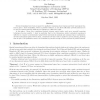Free Online Productivity Tools
i2Speak
i2Symbol
i2OCR
iTex2Img
iWeb2Print
iWeb2Shot
i2Type
iPdf2Split
iPdf2Merge
i2Bopomofo
i2Arabic
i2Style
i2Image
i2PDF
iLatex2Rtf
Sci2ools
AMAI
2000
Springer
2000
Springer
Using topology for spatial reasoning
Several formalisms have been proposed for qualitative reasoning about regions and their topological relations in space. These formalisms, based on pairwise relations, do not allow sufficiently powerful inferences to be used for spatial reasoning tasks such as planning a collision-free path. In this paper, I show how considering relations between region triples, much more powerful reasoning techniques become possible. I show in particular that in two dimensions, purely topological reasoning is sufficient to compute a minimal place graph which represents all minimal and maximal region combinations, as well as all minimal paths between them. I illustrate how this could be applied to motion planning, showing that in spite of its qualitative nature, the formalism is powerful enough to solve problems of pratical interest.
AMAI 2000 | Artificial Intelligence | Powerful Reasoning Techniques | Reasoning | Spatial Reasoning Tasks |
| Added | 01 Aug 2010 |
| Updated | 01 Aug 2010 |
| Type | Conference |
| Year | 2000 |
| Where | AMAI |
| Authors | Boi Faltings |
Comments (0)

